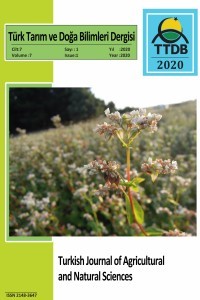
Türk Tarım ve Doğa Bilimleri Dergisi
Yazarlar: Yildiz SOKAT
Konular:-
DOI:10.30910/turkjans.570925
Anahtar Kelimeler:Oregano,Weeds,Control,Alternative control
Özet: Oregano is one of the important export products of medicinal and aromatic plants. Oregano, which is mostly consumed as a spice, is used in many areas. Intensive production is carried out in the Aegean Region, especially in Denizli. In the study carried out in the production areas of the Denizli oregano (Origanum onites L.) in the province of Denizli; determination of weed species, frequencies and densities in the Denizli oregano production areas, and how to controlling them were investigated. Surveys, in 2013, were conducted in 770 decares of land, 68 fields which are randomly chosen. ¼ m2 frames were used according to the field’s size in weed counts to count the occurrences of weeds based on their species. From the data obtained, the weed density and the frequency of incidence in the m2 were determined. Controlling works were carried out in Gözler, Denizli, in 2014 and 2015. In the experiment; mechanical (hand and tractor hoe), physical (mulching), chemical (herbicide with pendimethalin active substance) and alternative (olive waste, cabbage waste) methods of controlling were investigated. As a result of surveys, 31 different weed species belonging to 127 families were determined. It was observed that two of these species were endemic (Alyssum fluvescens var. stellatocarpum and Iberia carica), two of them were parasitic (Cuscuta campestris Yuncker and Orabanche gracilis SM.), fourteen of them were narrow-leaved, others were broad-leaved weed species. It is also observed that the intensive spicy is Convolvulus arvensis L. (2.74 plant/m2) among broad-leaf weeds. Respectively it is followed by Tragopogon dubius Scop. (0.87 plant/m2), Chondrilla juncea L. (0.60 plant/m2). On the other hand, the intensive spicy among narrow-leaved weeds is Bromus tectorum L. (1.02 plant/m2), and it is followed by the Poa annua L.(0.83 plant/m2). In addition, number of weeds in efficacy (%) values best results in mulch applications and they are followed pendimethalin, by hand hoe, olive prina, cabbage waste, applications. On the other side, dry weight in efficiency (%) values best results in hand hoe and pendimethalin applications and other applications results in different groups were determined.